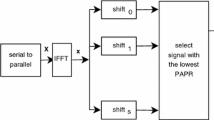Abstract
Selected mapping (SLM) is a technique for reducing the high peak-to-average power ratio (PAPR) in which a suitable signal is selected among a set of alternative signals which all indicate alike information. The chief drawback existing in this method is that transmitter is compelled to send several additional bits called side information (SI) for each data block in order that recovering at the receiver side can be possible. In this paper, we present a novel SLM scheme by using the linear feedback shift register circuit and m-sequence named MSLM technique by which any side information bit is not explicitly sent. In MSLM, The basic idea is to fit the side information into transmitted symbols based upon which some special locations in the transmitted data block are expanded, i.e. some transmitted symbols are extended. In the receiver side, by using some properties of m-sequence the SI bits can be detected. We present the example of our method for an OFDM system through the use of 16-QAM modulation and different m-sequences and finally, concerned results are illustrated from the view point of bit error rate, probability of detection failure and PAPR reduction.





Similar content being viewed by others
References
Weinstein, S. B., & Ebert, P. M. (1971). Data transmission by frequency division multiplexing using the discrete Fourier transform. IEEE Transactions on Communications Technology, 19(5), 28–34. doi:10.1109/TCOM.1971.1090705.
Richard, V. N., & Prasad, R. (2000). OFDM for wireless multimedia communications. Artech House. doi:10.1109/WCNC.2000.904862.
Nuaymi, L. (2007). WiMAX-technology for broadband wireless access. New York: Wiley. doi:10.1002/9780470319055.
Ochiai, H., & Imai, H. (2002). Performance analysis of deliberately clipped OFDM signals. IEEE Transactions on Communications, 50(1), 89–101.
Kang, S. G., Kim, J. G., & Joo, E. K. (1999). A novel sub block partition scheme for partial transmit sequence OFDM. IEEE Transactions on Broadcasting, 45(3), 333–338.
Bäuml, R. W., Fischer, R. F. H., & Huber, J. B. (1996). Reducing the peak-to-average power ratio of multicarrier modulation by selected mapping. Electronis Letters, 32(22), 2056–2057.
Li, X. D., & Cimini, L. J. (1998). Effects of clipping and filtering on the performance of OFDM. IEEE on Communications Letters, 2(5), 131–133. doi:10.1109/VETEC.1997.605835.
Ochiai, H., & Imai, H. (2000). Performance of the deliberate clipping with adaptive symbol selection for strictly band-limited OFDM systems. IEEE Journal on Selected Areas in Communications, 18(11), 2270–2277. doi:10.1109/49.895032.
Han, S. H., & Lee, J. H. (2005). An overview of peak-to-average power ratioreduction techniques for multicarrier transmission. IEEE on Wireless Communications, 12(2), 56–65. doi:10.1109/MWC.2005.1421929.
Jiang, T., & Wu, Y. (2008). An overview: Peak-to-average power ratio reduction techniques for OFDM signals. IEEE Transactions on Broadcasting. doi:10.1109/TBC.2008.915770.
Simon, M. K. (1994). Spread spectrum communications handbook. Boston: McGraw-Hill. doi:10.1081/E-EWMC-120043935.
Don, T. (2004). Principles of spread spectrum communication systems. Berlin: Springer. doi:10.1007/978-1-4419-9595-7.
Golomb, S. W., & Gong, G. (2005). Signal design for good correlation. Cambridge: Cambridge University Press. doi:10.1017/CBO9780511546907.
Williams, M., & Sloane, F. J. (1976). Pseudo-random sequences and arrays. Proceedings of the IEEE. doi:10.1109/PROC.1976.10411.
Stephane, Y., Le Boon, K. K., Charalampos, C. T., & Bayan, S. Sh. (2008). A novel selected mapping technique for PAPR reduction in OFDM systems. IEEE Transations on Communications. doi:10.1109/TCOMM.2008.070021.
Tellambura, C. (2001). Computation of the continuous-time PAR of an OFDM signal with BPSK subcarriers. IEEE Communications, 5(5), 185–187. doi:10.1109/4234.922754.
Author information
Authors and Affiliations
Corresponding author
Rights and permissions
About this article
Cite this article
Meymanatabadi, S., Musevi Niya, J. & Mozaffari, B. Selected Mapping Technique for PAPR Reduction Without Side Information Based on m-Sequence. Wireless Pers Commun 71, 2523–2534 (2013). https://doi.org/10.1007/s11277-012-0953-3
Published:
Issue Date:
DOI: https://doi.org/10.1007/s11277-012-0953-3




